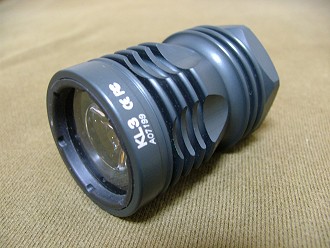ApexShootingTactics wrote:
There are several others with very slight ridges and valleys on the bezel. Theses are not considered to be aggressive cutting bezels but are more like vents to allow heat to escape in the event you place a light lens down in a pouch or pocket without turning it off. These gaps allow heat to escape.
Just a quick point of clarification from a confessed flashaholic....

Those shallower scallops/ridges aren't for heat escape. Modern LEDs do not project "forward heat" - heat emitted as infrared radiation, forward of the light. Rather, heat is produced "internal" to the device. The heat-sinks "fins" such as what's seen on the middle, slim light as well as on the light that's the second from the right allows for better cooling of the "star," much as similarly constructed heat sinks inside a computer power unit does. OK, actually, in-truth, those machined areas on the Streamlights probably aren't even "cooling fins," and are probably just styling elements, the old Surefire KL3 head (one of the first commercial "rough use" LED conversion heads) utilized cooling fins:

...and some of Surefire's modern, ultra-high-output lights (Invictus, top, Dominator, below) still do:


For certain lights, their entire bodies help conduct heat away from the LED "star." Lights like the ARC LS, one of the first high-power, ultra-compact/ultra-lightweight handhelds, example, can actually get slightly uncomfortable to hold after being on for extended periods of time. However, if the light was left on, say, on a table top, it'll actually get so hot that you won't want to pick it up. Holding on to it makes your whole body (well, at least your hand!

) the heat-sink.
Back in the days when folks started cranking up the output on halogen incandescents, forward-heat was indeed a very real concern. We have to remember here that at least for the retail market, even as close as 2001, "high-power tactical flashlights" were still in the 60 to 90 lumens range (think Surefire's old P90 and MN03 bulb units; note here that we're not talking about the powerhouses such as the 10X Dominator, M3T, or the M6, which at between 250 to 500 lumens, were designed for serious throw and were too bulky for civilian concealed-carry; and yes, before anyone asks, I still have my old M6, which has for the last few years worn the Malkoff MD60 drop-in, trading throw for run-time and utility in my context, and my old C3 Centurion uses a M91A) - one doesn't have to look much beyond publications such as Ken Good's "The Strategies of Low Light Engagements" to realize how far the technology jumped in those few years between 2001-2004. Back when we were still using halogen incandescents and forward heat was actually a concern, someone came up with the idea of machining a few relief cuts in the bezel not so much as to evacuate heat, but rather, so that we dumb end-users could easily see that we left the light on with the bezel-down, and that whatever we'd set our lamp on was about to get, literally, scorched - if not outright torched.
This is why when you accidentally engage and leave-on a modern high-powered LED flashlight in your pants pocket, your entire upper thigh feels hot, instead of it being a focal burning sensation. That entire flashlight is getting hot as it's getting conducted "backwards." (Sure, the head gets hot, first, as the heat from the star first soaks the heat-sink there and then migrates to the body of the light, and that might cause a bit more discomfort there, but trust me, it's not because of the light being produced, versus a halogen incandescent filament burner.

)
So don't get caught up with buying a light that has an aggressive bezel. Worry about lumens, durability and function. Keep checking back for more flashlight tips.
^ This, I agree with wholeheartedly.
That, and heck, your pants (if you carry bezel-down) or your hand/fingers (if you favor bezel up) will thank you!
-----
For those wishing for a real-world tie-in, the new Cree indoor LED lamps utilize convection instead of conduction for cooling of its star:
http://spectrum.ieee.org/tech-talk/semi ... r-led-bulb" onclick="window.open(this.href);return false;
And I know that some of you have noticed those nifty LED headlamps on Audis (and heck, even the budget Toyota Corolla!). When the R8 first came to the scene with LED headlamps (
http://www.caranddriver.com/features/20 ... headlights" onclick="window.open(this.href);return false; and
http://www.autoblog.com/2008/05/30/audi ... headlamps/" onclick="window.open(this.href);return false;), we car-nuts and flashaholics marveled at the ingenious design: that the fans which cooled the stars would also port heat to the outer aero covering so as to defrost/defog the light, thereby eliminating that dread effect many of us here in NE-Ohio have seen back when they first introduced LED traffic signals: that snow often blocked the lights' entire output.





